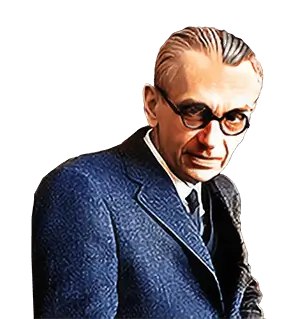Gödel’s 1934 Undecidability lectures
Page last updated 20 July 2022
This article demonstrates the inherent conflation of language in lectures given by Gödel at the Institute for Advanced Study during the spring of 1934, the notes of which were taken by S. C. Kleene and J.B. Rosser.
Gödel, Kurt. “On Undecidable Propositions of Formal Mathematical Systems, Mimeographed lecture notes by SC Kleene and JB Rosser”, Institute for Advanced Study, Princeton, NJ (1934): 39-74,
also published in the books:
The undecidable: Basic papers on undecidable propositions, unsolvable problems and computable functions, ed Martin Davis, Raven Press Books, 1965, and
Kurt Gödel: Collected Works: Volume I: Publications 1929-1936. Vol. 1, ed Solomon Feferman, Oxford University Press, USA, 1986.
Note that in the following text, for clarity (as in my English translation of Gödel’s 1931 incompleteness paper) we shall give a blue background to all instances of formulas, variables, and numerical values of the formal system, or terms that indicate such sequences of the formal system.
In Section 5: Representation of recursive functions, Gödel defines a function
We abbreviate certain formal expressions as follows:
Gödel later in that section states:
In the Gödel Collected Works, Vol 1, the
…
and continues:
In fact, if
and also:
Hence there is a formula
and he continues:
Let
When Gödel states that
Analyzing Gödel’s argument
We follow the line of Gödel’s argument above while bearing in mind the ambiguity of what is intended by
and
so:
and so:
and since
(1)
We note that
The details of Gödel’s argument
It is noteworthy that Gödel never clearly defines the function
At this point we note that the fundamental underlying concept behind Gödel numbering is that, for every relationship that can be defined between two sequences of symbols
The key point here is that since
But if we look a bit more closely we see that when Gödel defines
which means that Gödel is substituting the term
But this means that the symbol sequence of the formal system that is to be substituted in the formal formula is a symbol sequence that corresponds, according to Gödel numbering, to the numerical value, not of
Gödel’s conflation of languages
If
and the two sides of the equality are always interchangeable - for any function
This means that if the format of numbers in the meta-language were also to be the same format
but at the same time the definition of
since the intended unique correspondence of every Gödel number to a specific singular symbol sequence. Hence
One might then wonder if the expression could be valid for a different level of language. Clearly, there cannot be an expression of the formal system that expresses the inner
One might consider that perhaps there is a possibility that the outer
An irredeemable flaw
It follows that there is no expression that is a logically valid implementation of Gödel’s notion of
and hence the argument that is based on that false premise is fundamentally flawed.
This should not be a surprise, since the fact that certain terms are referred to in an ambiguous manner should alert readers to the possibility of deflection or evasion. In these lectures, the function
The page Gödel’s Substitution Function gives a detailed analysis of Gödel’s incompleteness paper and how Gödel uses the false equivalence of his
A single arithmetical language?
Another way to demonstrate the conflation of language that is inherent in the above, all that is required is to observe that there is no reason at all in principle to use any mathematical system other than the formal system to express all the arithmetical relations and functions that are used. After all, since one of the principal claims is that the formal system can express all the arithmetical concepts used, then in principle, there is no problem whatsoever in stating all these concepts directly in the formal language. Of course, stating all the mathematical statements in the formal language would be extremely long-winded, but that in itself does not affect the underlying principle. Of course, it is also the case that if the formal system could not express the mathematical concepts used, then it would not be surprising at all if it were incomplete.
Furthermore, this simplifies matters immensely, since we should now only have one sub-language - the mathematical formal language - and one meta-language, the meta-language that talks about this mathematical sub-language, with no dichotomy of mathematical systems to confuse matters.
So, in this way, we produce a perfect separation of meta-language and sub-language - right?
Wrong…
Gödel’s numbering system
It is now patently obvious that the definition of the Gödel numbering system, since that definition necessarily requires mathematical functions, is itself a conflation of the meta-language and the mathematical sub-language. It involves a direct conflation of two distinct levels of language. Of itself, that does not result directly in any illogical statement, but it should be obvious that a careless usage of that numbering system can produce illogical results.
The crucial fact that must be recognized is that while every instance of the application of the Gödel numbering function on a sequence of symbols of the formal system always produces a unique corresponding number, the converse does not apply. Numbers can be generated entirely within the formal system that have no inherent correspondence by Gödel numbering to sequences of the formal system, but which happen to have the same format as a Gödel number. Assuming, as Gödel does, that one can treat such instances as though they are numbers that correspond by Gödel numbering to sequences of the formal system is patently absurd. See also the paper The Fundamental Flaw in Gödel’s Proof of his Incompleteness Theorem for more on the absurdity of assuming false equivalence.
The resultant discrepancies, such as statements that appear to self-reference, rather than indicating some profound insight regarding incompleteness, are merely indicators of the underlying problem, and are the result of the confusion engendered by the fact that Gödel’s meta-language refers, on the one hand, to number-theoretic relations as objects, which means that any system of number-theoretic relations (including the formal system) that he refers to is a sub-language to that meta-language, but at the same time, on the other hand, this meta-language uses number-theoretic relations as an inherent part of that meta-language in order to define the Gödel numbering system.
It is this fact that there are
- numbers in number-theoretic relations/
functions that do logically correspond to sequences of symbols of the formal system by Gödel numbering
but also - numbers in number-theoretic relations/
functions that do not logically correspond to sequences of symbols of the formal system by Gödel numbering
that results in the confusion and apparent self-reference, since it is inevitable that there can be confusion as to which numbers can logically correspond to sequences of symbols of the formal system. It is precisely this confusion which Gödel uses to produce his illogical result.
Conclusion
There is no logical “undecidability” result as indicated by Gödel’s fallacious outline proof. A proof by contradiction - as is the proof in these lectures, and indeed in his original incompleteness proof - simply means that the contradiction indicates that at least one of the prior assumptions is wrong or/and one of the steps is incorrect. Gödel’s naive presumption is that the contradiction engendered by his outline proof
The contradiction generated by an assumption that a certain statement or its negation must be provable, vis-a-vis the appearance (generated by language conflation) that neither the statement nor its negation is provable.
was simply the direct result of the assumption that the formula
The above demonstrates the folly of the attempt to make a formula of a well-defined consistent formal system self-reference. It should be obvious that the apparent self-reference is not within the formal system, since without any mention of the Gödel numbering function, the formal system formula shows no self-reference whosoever. In the lectures, where it is claimed that a formal system statement appears to refer to itself as:
and where
That conflation is a clear demonstration of the abject futility of such attempts at proving incompleteness, where primitive recursive functions are described in detail, and then the application of such to an actual formal system is skimmed over with no attention to detail. For the simple-minded, the fudge succeeds in concealing the real conflation of meta-language and sub-language that is the nub of the flaw in Gödel’s proof.
Some other remarks
Reading the lecture notes, it is readily apparent that almost all of the material is on primitive recursive functions and relations, and assertions as to how the computability of such functions and relations means that they are expressible in the formal system. But the crucial aspects of meta-language and sub-language are only afforded a few brief paragraphs.
In the lectures, Gödel places a lot of emphasis on constructibility, but for an entity to have the property that it can be constructed simply means that it is a sequence of symbols that is generated by prior sequences of symbols, either directly in the paper itself, or indirectly referred to by the paper. As such, being constructible, of itself, does not confer on an entity some sort of mathematical validity, since any such validity depends on the entire chain of construction, and it only takes one faulty link in the chain to destroy the assumed validity of the construction. And since, as demonstrated above, and elsewhere on this site, Gödel’s construction conflates at least two levels of language, the constructibility of Gödel’s sequence is worthless.
The text of Gödel’s undecidability paragraphs
Let
Next we raise the question of whether



Rationale: Every logical argument must be defined in some language, and every language has limitations. Attempting to construct a logical argument while ignoring how the limitations of language might affect that argument is a bizarre approach. The correct acknowledgment of the interactions of logic and language explains almost all of the paradoxes, and resolves almost all of the contradictions, conundrums, and contentious issues in modern philosophy and mathematics.
Site Mission
Please see the menu for numerous articles of interest. Please leave a comment or send an email if you are interested in the material on this site.
Interested in supporting this site?
You can help by sharing the site with others. You can also donate at where there are full details.
where there are full details.